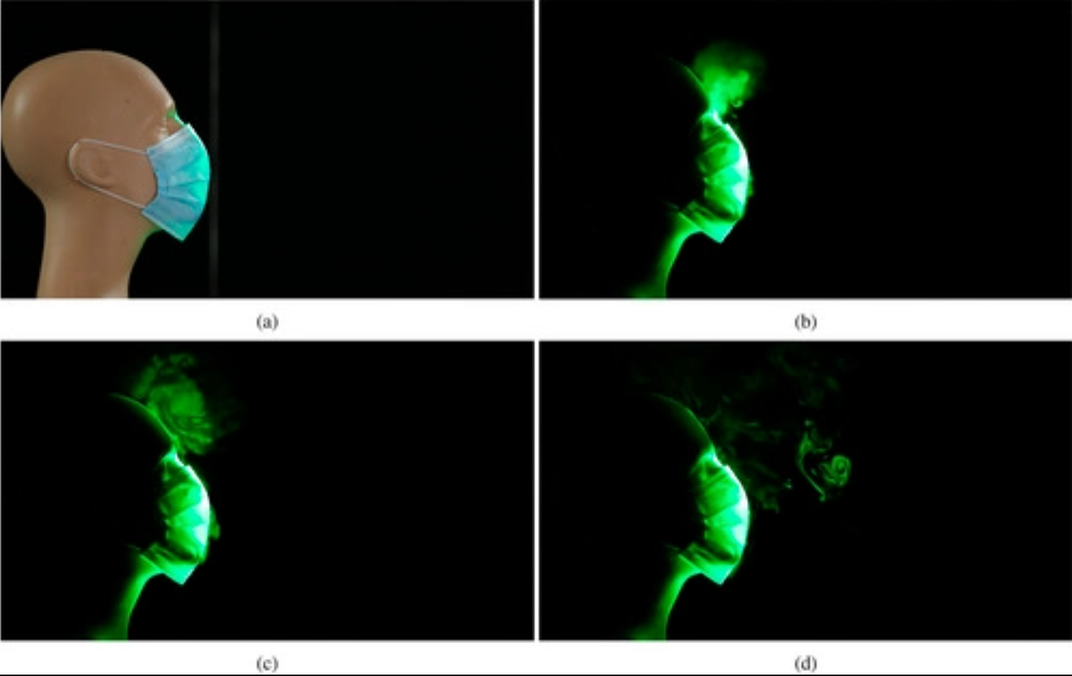Face Shields and Valved Masks Don’t Fully Stop the Spread of Aerosols
A new visualization shows how droplets from a cough or sneeze escape around the sides of a plastic face shield
/https://tf-cmsv2-smithsonianmag-media.s3.amazonaws.com/filer/8a/06/8a062b8e-abf1-48dc-98ce-e422c2fb750a/2020_sep3_faceshield.jpg)
A new visualization created by scientists at Florida Atlantic University shows that face shields and masks with valves don’t stop small droplets from traveling from person to person.
The Centers for Disease Control and Prevention recommends wearing a cloth mask that covers the mouth and nose, maintaining a physical distance from others and washing hands frequently to prevent the spread of the virus that causes Covid-19. The CDC already warns against wearing only a face shield, which is made of transparent plastic and sit a few inches in front of the face.
The visualization published this week in the Physics of Fluids shows how the droplets from a cough or sneeze easily drift around the shield to the rest of the room.
“People need to be aware of the limitations of the face shield as a way to protect others from an infected cough,” Manhar Dhanak, study author and chair of the Department of Ocean and Mechanical Engineering at Florida Atlantic University, says to Gizmodo’s Ed Cara in an email.
The study also examined masks with valves that are designed to open when the wearer exhales. This style of mask is normally worn by workers at construction sites to prevent inhalation of dangerous particles from the materials they work with. Valved masks aren’t allowed in medical settings because when the wearer exhales, germs can escape out the valve, Tara Parker-Pope reports for the New York Times.
But face shields and valved masks have grown in popularity as municipalities create mask mandates because they’re more comfortable, the researchers write. For fluid mechanics expert and first author Siddhartha Verma, the study is a visual reminder: people should wear masks that will prevent the droplets in their breath from spreading.
"That was sort of the main motivation for us to do this study – to show people what actually happens," Verma tells Emma Betuel at Inverse.
The researchers also found that many knock-off valved masks are faulty, according to the New York Times. The knock-offs are designed to look like N95 masks with valves, but the valves don’t open and close with the wearer’s breathing. Instead, the valves sometimes just stayed open, leaving the wearer with a gaping hole in their mask.
The visualizations use a mannequin head wearing different face coverings and a pump that sprays a vapor of water and glycerin. A green laser system lights up the droplets after they’re sprayed from the mannequin’s mouth, literally highlighting the droplets’ path.

“The shield helps to stop direct projection of a cough onto others, particularly during short encounters,” Dhanak wrote to Gizmodo. “However, the aerosolized droplets linger and can spread significant distances from the source.”
In the video, the cloud of droplets first gathers behind the face shield and then floats around it and into the rest of the room. And in the valved mask tests, a plume of droplets shoots downward from the mask while a smaller spray goes upward. The researchers also tested the set-up with a non-valved N95 mask, which sent some breath upward, and a surgical mask, which also sent air upward and small amount through the mask.
“These visualizations are really powerful for helping the general public to see and understand what’s happening,” says Linsey Marr, who studies aerosols at Virginia Tech and wasn’t involved in the study. “Air can’t pass through the face shield — it has to bend and go around the shield. The aerosols are going to follow that air flow around the shield. It’s not going to splat.”
The visualization is just a simulation of a cough or sneeze. The study doesn’t give a detailed description of the conditions of the room where the researchers created the visualization, Richard Flagan, who studies aerosols at CalTech, tells Inverse. But it’s still a powerful reminder of what kinds of masks are most effective at keeping our germs to ourselves and even protecting us.
"A face shield by itself is not going to protect the wearer very much," Flagan tells Inverse. "It won't protect people in the vicinity of the person that's wearing it."

